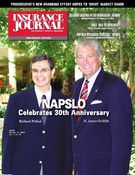Due to efforts to rebuild the Florida property insurance market after Hurricane Andrew, most policyholders in the wake of 2004s more costly hurricane season should not face the same post-Andrew price increases or limited availability of homeowners’ insurance. Voices are beginning to call for weakening some of the post-Andrew changes, most notably limiting insurers’ use of percentage hurricane deductibles. Such a move would be shortsighted and ultimately a costly mistake for the people of Florida.
Hurricane Andrew, with $15 billion in insured losses — threw Florida’s property insurance market into chaos, many carriers discovered they had miscalculated their exposure to large weather-related losses.
Rebuilding began — for policyholders and insurers. Insurers anxious to stay in the state reassessed their risk models, spread risk over a broader geographic area and replenished reserves to prepare for more hurricanes. The impact on policyholders anxious for coverage was higher prices for homeowners insurance and fewer (or no) choices for coverage.
Insurance companies, state regulators and elected officials faced serious challenges immediately after Andrew:
A severe imbalance between the need for insurance and the industry’s capacity to provide it;
A fast-growing economy and population growth that was drawing hundreds of thousands of new residents, resulting in a rapid growth in new residential and commercial construction in the most dangerous “hurricane alley” in the United States;
Reinsurers demanded that primary carriers greatly reduce their potential maximum losses from such storms;
The prospect that the residual market might have to take in up to 50 percent of all residential policyholders, charging higher rates than the private market for less coverage, with the rest of the state’s policyholders subsidizing it through assessments;
A growing number of uninsured property owners who, in the wake of the next hurricane, would turn to the federal and state governments to rebuild their lives, all at the ultimate expense of the taxpayer.
Without drastic action to rebuild the insurance market after Andrew, the entire Florida insurance system and economy would have been in jeopardy.
In response, Florida began key private-public programs so insurance would be available and affordable in Florida. Four major programs fulfilled twin goals of keeping insurers writing homeowners’ coverage and providing insurance to those at greatest risk: First, the Florida Hurricane Catastrophe Fund, which provides reinsurance for insurers; Second, Citizens Property Insurance Corporation and its predecessors, the “insurer of last resort” for homeowners who can’t find coverage in the voluntary market.
Third, the law that allows insurers to use catastrophe models to forecast future losses and maintain adequate rates and surplus.
Fourth, as in 16 other hurricane-prone states — lawmakers passed legislation requiring carriers to impose percentage hurricane deductibles based on the home’s insured value. By requiring Florida’s policyholders to share in the risk of loss, insurers can make coverage more affordable and available.
Property insurance reforms were approved by the Legislature and signed into law only after extensive debate and thorough review by policymakers of the reforms’ impact on policyholders and carriers.
The legislation authorizing insurer use of percentage deductibles helped build capacity in the private market by giving companies an additional tool to manage their exposures and maintain their presence in Florida. Keeping exposure in the private market is preferable because it allows carriers to spread risk throughout the global reinsurance market.
Percentage deductibles also come with important consumer benefits, including a lower premium in exchange for a higher deductible and guaranteed renewal for the next policy term for many higher-priced homes. And in the case of multiple claims/multiple deductibles, the full policy limits are available for subsequent occurrence(s).
Putting limits on the use of deductibles will not decrease policyholders’ total monetary outlay for windstorm coverage because carriers will need to increase premiums to offset their increased exposure. And limiting deductibles without an equal and offsetting increase in rates will force carriers to reduce the amount of insurance they can write, thus putting more policies into Citizens. Citizens has the authority to assess all policyholders if claims payments deplete its surplus. The ultimate result of limiting hurricane percentage deductibles is that all policyholders — not just those who filed claims for windstorm damage — will pay more for insurance.
The final lesson of Hurricane Andrew is that although human tragedy understandably generates talk of “change,” the continued vitality of the Florida property insurance market requires careful consideration of all proposed “solutions.”
Cecil Pearce is the vice president, Southeast region, for the American Insurance Association (AIA). He joined AIA in 1992, and previously, for six years served as president of the Florida Insurance Council.
Topics Catastrophe Natural Disasters Carriers Florida Legislation Hurricane Property Homeowners Market
Was this article valuable?
Here are more articles you may enjoy.


 Why Reciprocal Insurance Exchanges Are Back in Fashion
Why Reciprocal Insurance Exchanges Are Back in Fashion  Litigation Finance Hits a Wall After Bets on Huge Gains Falter
Litigation Finance Hits a Wall After Bets on Huge Gains Falter  Airline Pilots Hide Mental Health Struggles to Keep Flying
Airline Pilots Hide Mental Health Struggles to Keep Flying  Dozens of State Attorneys General Urge Congress Not to Block AI Laws
Dozens of State Attorneys General Urge Congress Not to Block AI Laws 


